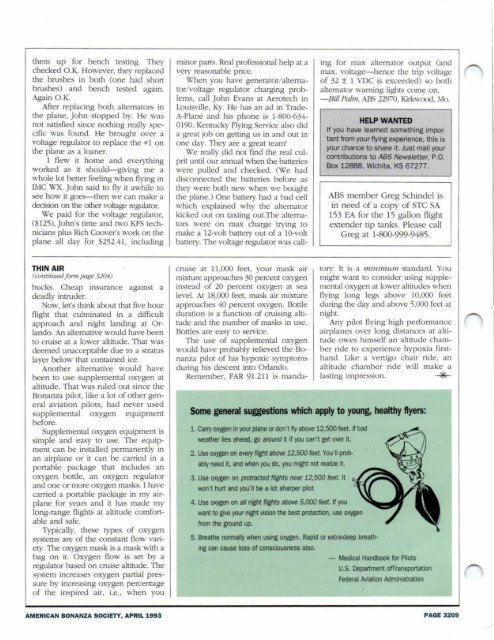April 1993 - American Bonanza Society
April 1993 - American Bonanza Society
April 1993 - American Bonanza Society
Create successful ePaper yourself
Turn your PDF publications into a flip-book with our unique Google optimized e-Paper software.
them up for bench testing. They<br />
checked OX However, they replaced<br />
the brushes in both (one had short<br />
brushes) and bench tested again.<br />
Again OX<br />
After replacing both alternators in<br />
the plane, John stopped by. He was<br />
nO( satisfied since nothing really specific<br />
was found. He brought over a<br />
voltage regulator to replace the # 1 on<br />
the plane as a loaner.<br />
r flew it home and everything<br />
worked as it should-giving me a<br />
whole lot better feeling when flying in<br />
!Me WX. John said to fly it awhile to<br />
see how it goes-then we can make a<br />
decision on the other voltage regulator.<br />
We paid for the voltage regulator,<br />
(5125), John's time and two KFS technicians<br />
plus Rich Coover's work on the<br />
plane all day for 5252.41, including<br />
ing for max alternator output (and<br />
max. voltage-hence the trip voltage<br />
of 32 ± 1 VDC is exceeded) so both<br />
alternator warning lights come on.<br />
-Bill Palm; ABS 22970, Kirkwood, Mo.<br />
HELP WANTED<br />
If you have learned something important<br />
from your fiying experience, this is<br />
your chance to share it. Just mail your<br />
contributions to ABS Newsletter, P.O.<br />
Box 12888, Wichita, KS 67277.<br />
ABS member G reg Schindel is<br />
in need of a copy of STC SA<br />
153 EA for the 15 gallo n flight<br />
extender tip tanks. Please call<br />
Greg at 1-800-999-9485.<br />
THIN AIR<br />
(continlledjonll page 3204)<br />
bucks. Cheap insurance against a<br />
deadly intruder.<br />
Now, let's think about that five hour<br />
flight that culminated in a difficult<br />
approach and night landing at Orlando.<br />
An alternative would have been<br />
to cruise at a lower altitude. That was<br />
deemed unacceptable due to a stratus<br />
layer below that contained ice.<br />
Another alternative would have<br />
been to use supplemental oxygen at<br />
altitude. That was ruled out since the<br />
<strong>Bonanza</strong> pilot, like a lot of other general<br />
aviation pilots, had never used<br />
supplemental oxygen equipment<br />
before.<br />
Supplemental oxygen equipment is<br />
sim ple a nd easy to use. The equipmem<br />
can be installed pennanently in<br />
an airplane or it can be carried in a<br />
portable package that includes an<br />
oxygen bottle, an oxygen regulator<br />
and one or more oxygen masks. I have<br />
carried a portable package in my airplane<br />
for years and it has made my<br />
long-range flights at altitude comfortable<br />
and safe.<br />
Typically, these types of oxygen<br />
systems are of the constant flow variety.<br />
The oxygen mask is a mask with a<br />
bag on it. Oxygen flow is set by a<br />
regulator based on cruise altitude. The<br />
system increases oxygen partial pressure<br />
by increasing oxygen percentage<br />
of the inspired air, i.e., when you<br />
minor parts. Real professional help at a<br />
very reasonable price.<br />
When you have generator/ alternator/<br />
voltage regulator charging problems,<br />
call John Evans at Aerotech in<br />
Louisville, Ky. He has an ad in Trade<br />
A-Plane and his phone is 1-800-634-<br />
0190. Kentucky Flying Service also did<br />
a great job on getting us in and out in<br />
one day. T hey are a great team!<br />
We really did not find the real culprit<br />
until our annual when the batteries<br />
were pulled and checked. (We had<br />
disconnected the batteries before as<br />
they were both new when we bought<br />
the plane.) One banery had a bad cell<br />
which explained why the alternator<br />
kicked out on taxiing out.The alternators<br />
were on max charge trying to<br />
make a 12-volt banery out of a lO-volt<br />
battery. The voltage regulator was callcruise<br />
at 11,000 feet j<br />
your mask air<br />
mixture approaches 30 percent oxygen<br />
instead of 20 percent oxygen at sea<br />
level. At 18,000 feet, mask air mixture<br />
approaches 40 percent oxygen. Bottle<br />
duration is a function of cruising altinlde<br />
and the number of masks in use.<br />
Bottles are easy to service.<br />
The use of supplemental oxygen<br />
would have probably relieved the <strong>Bonanza</strong><br />
pilot of his hypoxic symptoms<br />
during his descent into O rlando.<br />
Remember, FAR 91.211 is manda-<br />
(Ory. Tc is a minimurn standard. You<br />
might want to consider using supplemental<br />
oxygen a L lower altitudes when<br />
flying long legs above 10,000 feet<br />
during the day and above 5,000 feet at<br />
night.<br />
Any pilot flying high performance<br />
ai rplanes over long distances at altitude<br />
owes himself an altitude chamber<br />
ride to experience hypoxia first <br />
hand. Like a vertigo chair rid e, an<br />
a ltitude chamber ride will make a<br />
lasting impression.<br />
-@.--<br />
Some general suggestions which apply to young, healthy flyers:<br />
1. Carry oxygen in your plane or don't fly above 12,500 feet. ~ bad<br />
weather lies ahead, go around rt if you can't get over rt.<br />
2. Use oxygen on evel)' flight above 12,500 feet. You'li probably<br />
need it, and when you do, you might not realize it.<br />
3. Use oxygen on protracted flights near 12,500 feet. It<br />
won't hurt and you'll be a lot sharper pilot<br />
4. Use oxygen on aI/ night flights above 5,000 feet. If )'Ou<br />
want to give )'Our night vision the best protection, use oxygen<br />
from the ground up.<br />
5. Breathe nonnal ly when using oxygen. Rapid or extr

















